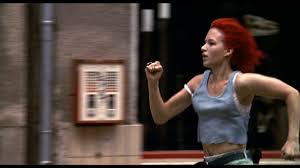Run Lola Run
In the movie “Run Lola Run” the director shows the fast-paced story of fate, chance, and human agency. The film tells the same story 3 different times. Lola, a young girl in Berlin, has 20 minutes to find 100,000 marks to save her boyfriend Manni after he loses a bag of money belonging to a criminal. Each version begins the same but unfolds very differently, creating a looping structure that challenges how we understand cause, effect, and consequences. The film’s plot twists are not random shocks; they emerge from small details that hint about the outcomes. The first major plot twist occurs when Lola fails to reach Manni in time. After being rejected by her father at the bank, she joins Manni in robbing a grocery store. The police arrive and chaos breaks out, and Lola is accidentally shot. Instead of the movie ending, the movie abruptly restarts, time runs backwards, and Lola is running down the stairs as if given another chance. This act transforms the movie from a normal thriller to a meditation on alternate possibilities and the fragility of timing. The second twist happens during the next run. Despite minor differences, Lola reaches her father sooner and robs the bank by herself. Even though she avoids the police, Manni is hit and killed by a truck. Once again, the time resets. The final twist comes in the final and most successful run. Lola misses her father entirely but wins money at the casino through sheer focus and determination. Manni independently resolves his own problem on his own. When the two finally reunite safely, the cycle finally ends. The three versions of the events suggest that fate is not entirely fixed, but influenced by awareness, decision, and random luck. Throughout the shifting timelines in the movie, Twyker plants subtle breadcrumbs that prepare the viewer for the change. Early shots of clocks, spirals, and the phone booth emphasize the time and repetition in the movie. The animated sequence of Lola running down the stairs, delayed slightly by her mother’s question, foreshadows slightly how small moments will alter the future outcomes. Quick photos flash by showing how bystander’s lives are affected just by bumping into her, hinting at the butterfly effect driving the film’s structure. Even the pulsating techno soundtrack, synchronizing with Lola’s steps, reinforces that her life is caught in a repeating rhythm only she can break. The film also uses many Chekhov’s gun devices. Objects or images introduced earlier in the movie that later have significance to the movie’s plot. The revolver, seen briefly in the first run, becomes vital in the second run when Lola uses it in the bank robbery. The ambulance, sitting in the background of the first two runs, finally becomes useful in the third run, as its slight delay works perfectly with Lola’s timing. The casinos roulette wheel mirrors earlier circular imagery like the phone dial and clock face, symbolizing chance and the clinical nature of the story. Even Manni’s lost money bag functions as an anchor for the narrative, drawing the characters fates back to the same point no matter what changes. Ultimately, “Run Lola Run” uses its plot twists to explore how tiny variations in behavior can reshape destiny. The film’s repeated structure, visual motifs, and careful foreshadowing turn what could be a simple action story into a philosophical reflection on time, control, and coincidence. By combining cinematic energy with structural precision, Tykwer shows that while life may depend on chance, awareness, and how the will to act can alter its outcome.

Provide Feedback